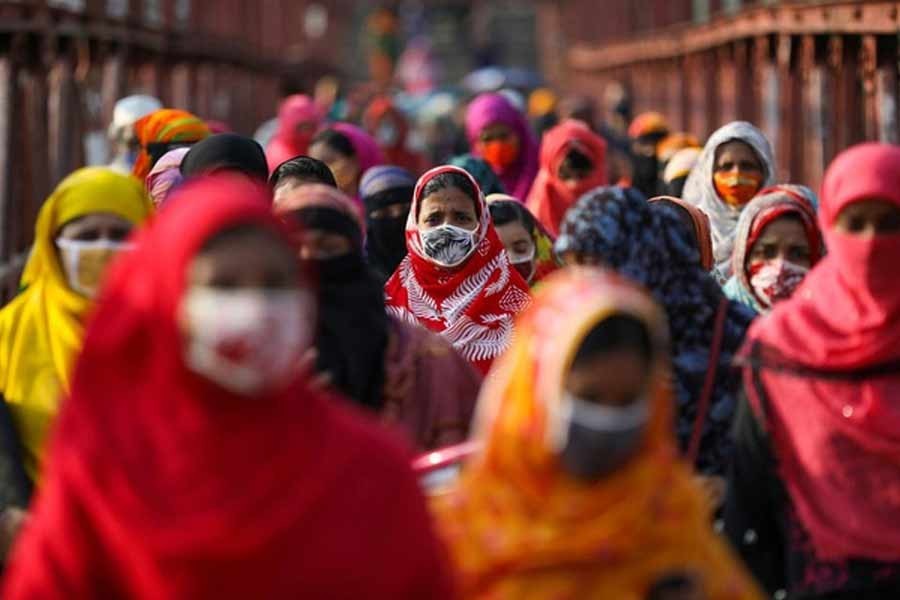Farida Begum served as a domestic help in three households in the city's Rampura area before the coronavirus pandemic arrived in Bangladesh.
But two of her employers told her not to come until the virus goes away. Her husband, who guarded a restaurant, also lost his job.
"We have come back to our village home in Madaripur finding no work," she told the FE over phone. "Our daughter, who works for a garment factory at Ashulia, also can't help us as she doesn't get full salary," she said.
Ms Begum is not alone to go back to her roots, an estimated 15,000 families have left Dhaka for villages since Bangladesh reported its first Covid-19 case on March 08.
Analysts said such reverse migration would depress rural wages and foment social tensions while the demand for house rent in the city areas would tumble.
They, however, said many of the wage earners will return to the city as soon as the wheel of economy starts running, but they may leave other family members, especially wives and children, behind.
Dr Ahsan H Mansur, Executive Director of the Policy Research Institute (PRI), a local think-tank, said the pandemic-hit economy may recover by the middle of next year, though it is hard to make a prediction.
People will again rush to big cities like Dhaka and Chattogram as soon as they find any job or come to know about job openings, he said, adding that many working people will return, leaving other family members behind.
"Low-income people are uncertain about their future livelihood, they don't know whether they will get back their jobs or whether their wages will return to the previous level," he said.
Dr Mansur said the majority of manufacturing units have resumed operations, but production volume is far below the capacity due to lower demand from the consumers' end.
However, the economist said, "It will take longer for some services and hospitality sectors to recover from the pandemic losses because consumers are spending less on non-essential and luxury products and services."
Investment in the public sector, especially the ones that generate jobs within a short time, must continue because the private sector will not start investing until the pandemic is over, he added.
It has been a common scene in the capital for last three months that people are leaving with belongings piled up in pickup trucks for villages or low-rent neighbourhoods and the landlords hang 'to-let' signs in front of their buildings.
Helal Uddin, a former government employee and a house owner in the city's Rampura Mohanagar Project, said three out of 11 flats of his six-storey building are now empty while another tenant would vacate it next month.
"It is true that many tenants are currently in financial problem, but I am also in peril as the building was constructed with bank loans and I have to pay installments every month," he said.
President of the Consumers Association of Bangladesh (CAB) Ghulam Rahman said that the house owners should be sympathetic towards the tenants because scores of low-income people have already left Dhaka while many others are searching for low-rent houses.
He predicted since the demand for accommodation goes down, the house rent in the coming days will also drop by at least 20 per cent because of the market mechanism.
He said the rent of office space would go further down because the 'work from home' culture has already developed in the country, which will push down the demand for premises.
President of the Bharatia Parishad (Tenants' Association) Bahrane Sultan Bahar said the house owners should consider reducing the rent during the pandemic and behave humanely with their tenants.
While there is no statistics of how many people have left Dhaka in the last four months, he estimated that some 10,000 to 15,000 families left the capital failing to pay rents and other expenses.
The South Asian Network on Economic Modeling (SANEM), a regional research institution, projected in early May the overall poverty rate is likely to double reaching 40.9 per cent from existing 20.5 per cent.
As per SANEM's estimates, around 34 million people may have emerged as "new poor" during the pandemic.
If it happens, poverty rate will be higher than it was 15 years back when around 40 per cent of the population was poor.
SANEM's early projection is almost consistent with the later calculation by the Centre for Policy Dialogue (CPD), which said the poverty rate rose to 35 per cent in 2020 in the country from 24.3 per cent in 2016 in the aftermath of the coronavirus pandemic.
Professor Dr C R Abrar, Executive Director of the Refugee and Migratory Movements Research Unit (RMMRU), said the pandemic has been forcing many families and wage earners to go reverse direction, leaving cities for villages, as they either lost jobs or their earnings declined.
The government does not have proper data about how many people have migrated to villages since the beginning of the pandemic or how many expatriate workers have returned home.
A proper data set is required for reaching the government support to the people in need, but irregularities in such programmes have been reported, he said.
Dr Sayema Haque Bidisha, a Professor of Department of Economics at the University of Dhaka, said that the very visible fallout of the Covid-19 pandemic is the reverse migration.
Migration from cities to rural areas will trigger an influx of labour in the rural economy, resulting in wage fall in the countryside, which can hardly absorb additional workforce due to mechanisation, she said.
She said the children of relocated families will drop out of school or be deprived of quality education while girls will become vulnerable to child marriage.
The labour and employment expert said that the coverage of social safety net programmes is a must to safeguard the new poor.


